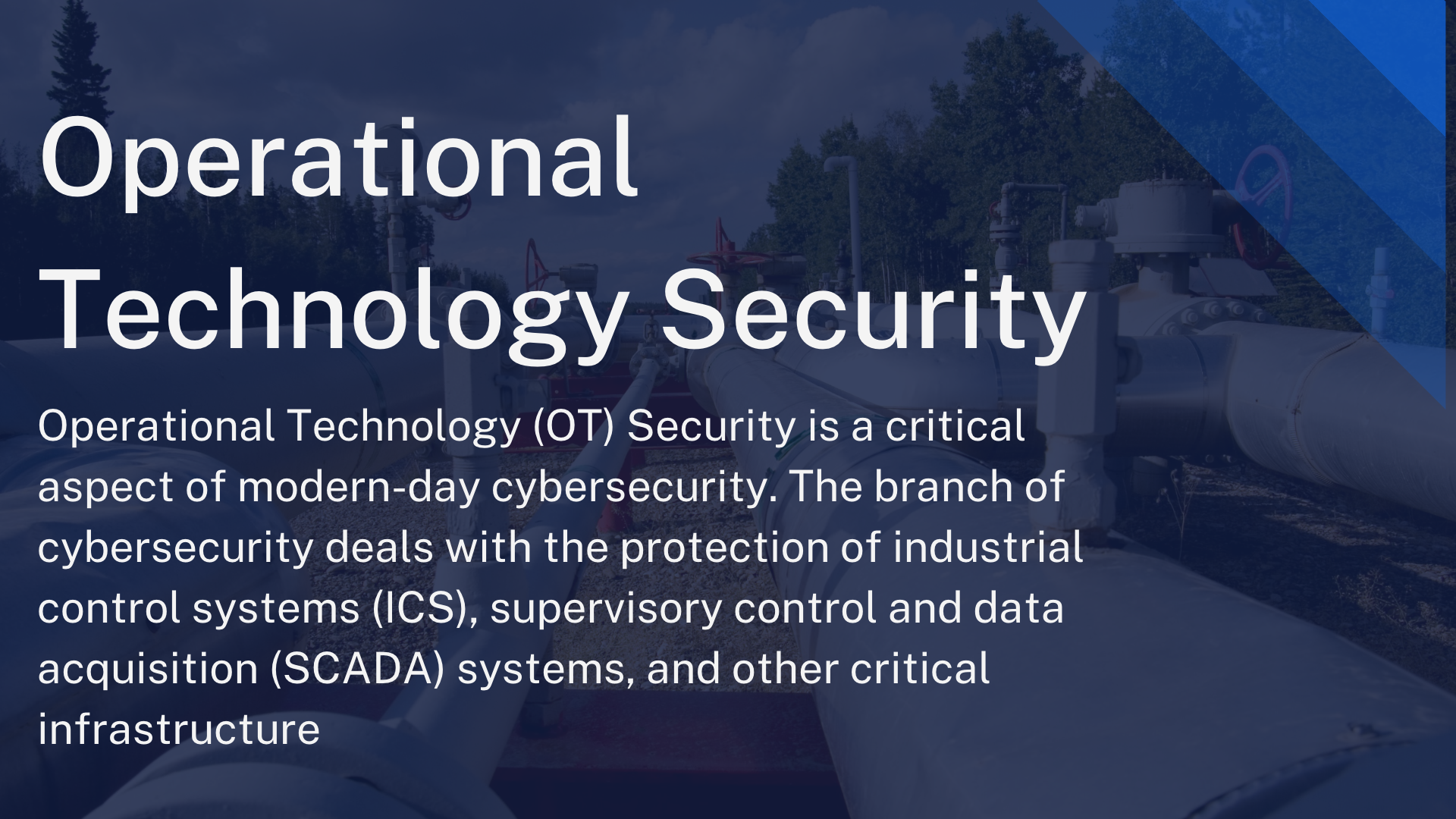Operational Technology Security: Understanding Its Importance in Today’s World
Operational Technology (OT) Security is a critical aspect of modern-day cybersecurity. The branch of cybersecurity deals with the protection of industrial control systems (ICS), supervisory control and data acquisition (SCADA) systems, and other critical infrastructure. OT systems are used in various sectors, including energy, transportation, manufacturing, and healthcare, to control and monitor physical processes.
OT systems are designed to control and monitor physical processes and are often connected to the internet, making them vulnerable to cyberattacks. A successful cyberattack on an OT system can have devastating consequences, including equipment damage, production downtime, and even loss of life. Therefore, it is crucial to secure these systems from cyber threats. This article will explore the basics of OT Security, including its definition, importance, and best practices for securing OT systems.
What Is Operational Technology Security?
Operational Technology (OT) Security is a set of practices and technologies to protect people, assets, and information, monitor and/or control physical devices, processes, and events, and initiate state changes to enterprise OT systems. It is designed to meet the unique security needs of OT environments, encompassing a broad range of programmable systems or devices that interact with the physical environment or manage devices that interact with the physical environment.
OT security is critical to protect all of our OT infrastructure’s hardware, software, and devices. It encompasses all of the steps we take to manage and monitor these devices from internal and external attacks and other cyber risks.
OT security differs from Information Technology (IT) security, which focuses on protecting data and information systems. On the other hand, OT security focuses on protecting the physical systems that control critical infrastructure, such as power grids, water treatment plants, transportation systems, and manufacturing facilities.
To protect OT systems, we need to understand OT-specific protocols and block attacks targeting the legacy systems commonly used in OT environments. We also need to ensure system availability and detect or cause a direct change by monitoring and/or controlling devices, processes, and events.
In summary, OT security is critical to protecting our critical infrastructure. We use practices and technologies to protect people, assets, and information, monitor and/or control physical devices, processes, and events, and initiate state changes to enterprise OT systems.

Why Is Operational Technology Security Important?
We understand the importance of operational technology (OT) security as a company. Integrating information technology (IT) and OT systems has become necessary for many organizations, but it also brings new risks that need to be addressed. This section will discuss why OT security is essential and how it can help protect critical infrastructure, mitigate cyber threats, and ensure business continuity.
Protecting Critical Infrastructure
OT systems manage and control critical infrastructure such as power plants, water treatment facilities, and transportation systems. A cyber attack on these systems can have severe consequences, including disruption of services, damage to equipment, and even loss of life. By implementing OT security measures, we can help protect critical infrastructure from cyber threats and ensure that these systems operate safely and efficiently.
Mitigating Cyber Threats
OT systems are becoming increasingly targeted by cybercriminals, who are looking to exploit vulnerabilities in these systems for financial gain or to cause disruption. These attacks can take many forms, including malware infections, denial of service attacks, and ransomware. By implementing OT security measures, we can help mitigate these threats and minimize the impact of any cyber attacks that do occur.
Ensuring Business Continuity
OT systems are critical to the operation of many businesses, and any disruption to these systems can significantly impact operations. By implementing OT security measures, we can help ensure that these systems remain operational and that our business can continue to operate in the event of a cyber-attack or other disruption. This includes regular backups, disaster recovery planning, and incident response planning.
In conclusion, OT security is essential for protecting critical infrastructure, mitigating cyber threats, and ensuring business continuity. We take these risks seriously and are committed to implementing OT security measures to protect our systems and customers.
Challenges of Operational Technology Security
When it comes to securing operational technology (OT) systems, there are several challenges that we face. This section will discuss some of the most significant challenges we encounter in OT security.
Legacy Systems and Equipment
One of the most significant challenges in OT security is the presence of legacy systems and equipment. Many OT systems were designed and implemented before security became a critical concern. As a result, these systems may lack basic security features, making them vulnerable to cyber-attacks. Also, these systems are often difficult to replace or upgrade due to their criticality and cost of replacement.
Lack of Standardization
Another challenge in OT security is the lack of standardization across different OT systems. Each OT system may have its own proprietary protocols, making implementing uniform security measures across an organization challenging. This lack of standardization makes developing and implementing effective security policies and procedures difficult.
Skills Gap
The skills gap is another significant challenge in OT security. Many organizations lack the personnel with the necessary skills and knowledge to secure OT systems effectively. This is partly due to the specialized nature of OT systems and the fact that they require a unique set of skills and expertise. As a result, organizations may struggle to find qualified personnel to manage and secure their OT systems.
We must take a comprehensive approach to OT security to overcome these challenges. This approach should include implementing security measures tailored to each OT system’s specific needs, developing and implementing effective security policies and procedures, and investing in personnel training and development. By addressing these challenges, we can ensure that our OT systems are secure and protected against cyber-attacks.
Best Practices for Operational Technology Security
When it comes to securing operational technology, there are several best practices that we should follow. These practices help to ensure that our systems and devices are protected from threats and vulnerabilities. This section will discuss some of the best practices for operational technology security.
Risk Assessment and Management
The first step in securing operational technology is to conduct a risk assessment. This involves identifying potential threats and vulnerabilities and assessing the likelihood and impact of these risks. Once we have identified the risks, we can develop a risk management plan to mitigate these risks.
Network Segmentation
Another critical best practice for operational technology security is network segmentation. This involves dividing our network into smaller segments, each with security controls. By segmenting our network, we can limit the impact of a security breach and prevent unauthorized access to critical systems and devices.
Access Control and Authentication
Access control and authentication are also critical components of operational technology security. We should implement strong access controls to limit access to critical systems and devices. This includes using strong passwords, multi-factor authentication, and role-based access control. We can prevent unauthorized access to our systems and devices by implementing these controls.
Employee Training and Awareness
Finally, employee training and awareness are essential for operational technology security. We should provide regular training to our employees to ensure they understand the importance of security and how to identify and report potential threats. By promoting a culture of security awareness, we can help to prevent security breaches and protect our systems and devices.
Securing operational technology requires a multi-faceted approach that includes risk assessment and management, network segmentation, access control and authentication, and employee training and awareness. By following these best practices, we can help to ensure that our systems and devices are protected from threats and vulnerabilities.
Operational Technology Security Solutions
Regarding protecting operational technology (OT) systems, several security solutions can help us keep them safe from cyber threats. This section will discuss some of the most common solutions we can use to secure our OT environments.
Intrusion Detection and Prevention Systems
Intrusion detection and prevention systems (IDPS) are designed to detect and prevent cyber attacks on OT systems. They work by monitoring network traffic and looking for signs of malicious activity. If an attack is detected, the IDPS can take action to prevent it from causing harm to the OT system.
Security Information and Event Management
Security information and event management (SIEM) systems are designed to collect and analyze security-related data from various sources. This includes data from IDPS, firewalls, and other security systems. SIEM systems can help us identify potential security threats and respond to them quickly.
Endpoint Protection
Endpoint protection solutions are designed to protect individual devices within an OT environment. This includes things like laptops, desktops, and mobile devices. Endpoint protection solutions can help us detect and prevent malware infections and other types of cyber attacks.
Data Encryption
Data encryption is an integral part of any OT security strategy. Encryption can help us protect sensitive data from being intercepted by cybercriminals. This includes passwords, credit card numbers, and other sensitive information.
In conclusion, we can use several security solutions to protect our OT systems from cyber threats. By combining these solutions, we can create a comprehensive security strategy that will help us keep our OT environments safe and secure.




